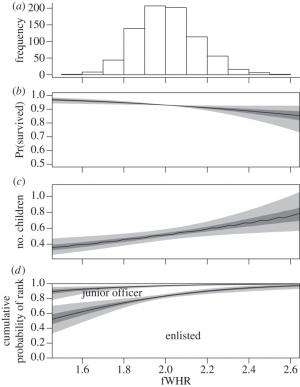May 9, 2013 report
Researchers find correlation between face shape and procreation rates and rank in male soldiers

(Phys.org) —Researchers in Finland, using photographs of soldiers marked with associated personal data have found that facial width to height ratio (fWHR) played a role in how many children they had and their rank. In their paper published in the journal Biology Letters, researchers John Loehr and Robert O'Hara describe how they measured the faces of men found in a war tribute book and compared them with personal data. Their study was part of an effort to see if they could find any correlations between wide-faced men and survival rates in war (possibly connected to aggressiveness). In so doing, they discovered some clear associations between wide faced-men and the number of children they had. They also found that narrow-faced men tended to rank higher than wide-faced men did.
This is not the first study to look for a correlation between male face shape and aggressive behavior. In 2008, Canadian researchers Justin Carré and Cheryl McCormick compared face shape and aggression in male hockey players—they found wider-faced men on average spent more time in the penalty box.
In this new effort, the researchers relied on books commemorating Finnish soldiers who served in WWII. Photographs showing the soldiers' faces were displayed along with personal data such as information marital status, number of children, rank achieved, etc. Also listed was information about where they had served and if they had survived the war.
Loehr and O'Hara scanned the faces of 795 of the soldiers (from three regiments) and then used a simple algorithm that gave a ratio of face height to width to come up with a fWHR for each one of them. Personal data given for each soldier was entered into a database along with the fWHR. Graphing software was then used to reveal trends.
In analyzing the graphs the researchers found that wide-faced men tended to have more children than those men with narrow faces. They also found that narrow-faced men tended to move up in rank more often than wide-faced men did. Face shape did not, however, appear to be connected to soldier survival rates in war. The researchers theorize that this is more likely due to modern warfare techniques and practices than aggressiveness in soldiers—when a shell lands in a foxhole, they note, everyone dies. They propose that wide-faced soldiers in more distant wars might have done better than their narrow-faced peers did if they were indeed more aggressive, as the Canadian study suggests. The thinking here is that aggressiveness would be an advantage in wars where soldiers had to rely on their own skills to survive, rather than sophisticated weapons.
More information: Facial morphology predicts male fitness and rank but not survival in Second World War Finnish soldiers, Published 8 May 2013 doi: 10.1098/rsbl.2013.0049
Abstract
We investigated fitness, military rank and survival of facial phenotypes in large-scale warfare using 795 Finnish soldiers who fought in the Winter War (1939–1940). We measured facial width-to-height ratio—a trait known to predict aggressive behaviour in males—and assessed whether facial morphology could predict survival, lifetime reproductive success (LRS) and social status. We found no difference in survival along the phenotypic gradient, however, wider-faced individuals had greater LRS, but achieved a lower military rank.
Journal information: Biology Letters
© 2013 Phys.org. All rights reserved.
















